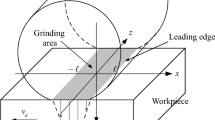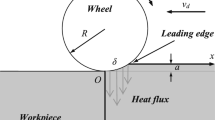Abstract
Considering the classical modelling of heat transfer in wet flat grinding [DesRuisseaux and Zerkle, J Heat Transf 92:456–464, 1970], we have calculated a closed-form expression for the surface temperature in the stationary regime. For any Peclet number and for small Biot numbers this closed expression can be computed much more rapidly than its equivalent integral form given in the literature. As an application, this result can be used to compute the maximum temperature of the workpiece very rapidly. We have seen that the numerical maximization of the surface temperature using the integral form given in the literature is extremely slow and sometimes fails. However, to prevent thermal damage, a fast computation of the maximum temperature is highly desirable for on-line monitoring in industrial grinding.




Similar content being viewed by others
References
Malkin S (1989) Grinding technology: theory and application of machining with abrasives. Ellis Horwood Ltd, England
Guo C, Malkin S (1995) Analysis of energy partition in grinding. J Eng Ind 117:55–61
Malkin S, Anderson R (1974) Thermal aspects of grinding, part I: energy partition. J Manuf Sci Eng 96:1177–1183
Lavine A (1991) Thermal aspects of grinding: the effects of heat generation at the shear planes. Ann CIRP 40:343–345
Lavine A (2000) An exact solution for surface temperature in down grinding. Int J Heat Mass Transf 43:4447–4456
Lavine A (1988) A simple model for convective cooling during the grinding process. ASME J Eng Ind 110:1–6
Pérez J, Hoyas S, Skuratov D, Ratis Y, Selezneva I, Fernández de Córdoba P, Urchueguía J (2008) Heat transfer analysis of intermittent grinding processes. Int J Heat Mass Transf 51:4132–4138
Carslaw H, Jaeger JC (1986) Conduction of heat in solids. Oxford Science Publications, Oxford
DesRuisseaux NR, Zerkle RD (1970) Temperature in semi-infinite and cylindrical bodies subjected to moving heat surfaces and surface cooling. J Heat Transf 92:456–464
DesRuisseaux NR (1968) Thermal aspects of grinding processes. PhD dissertation, University of Cincinnati
Skuratov D, Ratis Y, Selezneva I, Pérez J, Fernández de Córdoba P, Urchueguía J (2007) Mathematical modelling and analytical solution for workpiece temperature in grinding. App Math Mod 31:1039–1047
González-Santander JL, Isidro JM, Martín G (2014) An analysis of the transient regime temperature field in wet grinding. J Eng Math. doi:10.1007/s10665-014-9713-6
Jaeger JC (1942) Moving sources of heat and the temperature at sliding contracts. Proc R Soc N S W 76:204–224
Cameron A, Gordon AN, Symm GT (1965) Contact temperatures in rolling/sliding surfaces. Proc R Soc Lond A 286:45–61
Yevtuhenko A, Ukhanska O (1996) Plane quasi-stationary thermal problems with convective boundary condition. J Theor Appl Mech 34:143–158
Fischer FD, Werner E, Knothe F (2001) The surface temperature of a halfplane heated by friction and cooled by convection. ZAMM 81:75–81
Knothe K, Liebelt S (1995) Determination of temperatures for sliding contact with applicatios for wheel-rail systems. Wear 189:91–99
González-Santander JL, Pérez J, Fernández de Córdoba P, Isidro JM (2009) An analysis of the temperature field of the workpiece in dry continuous grinding. J Eng Math 67:165–174
González-Santander JL (2009) Modelización matemática de la transmisión de calor en el proceso del rectificado plano industrial. PhD dissertation, Universidad Politénica de Valencia. http://riunet.upv.es/handle/10251/4769
Abramowitz M, Stegun I (1972) Handbook of mathematical functions. NBS Applied Mathematics Series, vol 55, Washington
Gradsthteyn IS, Ryzhik M (2007) Table of integrals, series and products, 7th edn. Academic Press Inc, New York
Luke YJ (1950) Some notes on integrals involving Bessel functions. J Math Phys 29:27–30
Lebedev NN (1965) Special functions and their applications. Prentice-Hall Inc, New Jersey
Conway JB (1978) Functions of one complex variable. Springer, New York
Murav’ev VI, Yakimov AV, Chernysev AV (2003) Effect of deformation welding, and electrocontact heating on the properties of titanium alloy VT20 in pressed and welded structures. Metal Sci Heat Treat 45:419–422
Chapra SC, Canale RP (2010) Numerical methods for engineers. McGraw-Hill, New York
Apostol TM (1967) Calculus, vol 1. Wiley, New York
Olver FWJ, Lozier DW, Boisvert RF, Clark CW (2010) NIST handbook of mathematical functions. Cambridge University Press, New York
Acknowledgments
The authors wish to thank the financial support received from Universidad Católica de Valencia under Grant 2012-027-001.
Author information
Authors and Affiliations
Corresponding author
Appendix A
Appendix A
1.1 A.1 The \(\mathrm {Yu}\!\left( x\right) \) function
In the literature, we find [22, Eq. 13]
From (106) we can calculate the \(\mathrm {Yu}\!\left( x\right) \) function defined by the following integral:
1.1.1 A.1.1 \(x>0\)
Directly from (106) we have
1.1.2 A.1.2 \(x<0\)
Performing the change of variables \(u=-u^{\prime }\),
and applying again (106), we have
1.1.3 A.1.3 \(x\ne 0\)
For \(x\ne 0\) we can unify the results given in (107) and (108) as follows:
where
1.1.4 A.1.4 \(x=0\)
To evaluate \(\mathrm {Yu}{}_{\nu }\!\left( 0\right) \), let us calculate the following limit:
On the one hand, when \(\nu =0\), we have
Applying the asymptotic formulas [23, Eq. 5.16.4]
and taking into account (110), we have
On the other hand, when \(\nu \ne 0\), we can apply in (111) the asymptotic formula (113), so that
Therefore, according to (109), (114) and (115), we can express the \(\mathrm {Yu}{}_{\nu }\!\left( x\right) \) function as follows:
1.2 A.2 Convergence condition for \(\mathcal {T}\!\left( X,0\right) \)
According to [27, theorem 10.6], if a series \(\sum _{n=0}^{\infty }a_{n}\) converges, then \(\lim _{{n\rightarrow \infty }}a_{n}=0\). Therefore, the series given in (39),
converges if
Notice that according to (36),
and, according to [28, Eq. 10.41.2],
and thus
Notice as well that, according to Stirling’s formula [20, Eq. 6.1.37],
so that from (118) and (119) we have
Therefore, taking \(\nu =n/2\) in (120), we can calculate the following limit:
Thus, the condition given in (117) is satisfied when
1.3 A.3 Inequality for modified Bessel function of third kind
Let us consider the following integral representation of the modified Bessel function of the third kind [23, Eq. 5.10.23]:
Notice that the \(\cosh x\) function is a positive increasing function for \( x>0 \); thus,
Therefore, integrating in (122) and taking into account (121), we have
Rights and permissions
About this article
Cite this article
González-Santander, J.L., Martín, G. Closed form expression for the surface temperature in wet grinding: application to maximum temperature evaluation. J Eng Math 90, 173–193 (2015). https://doi.org/10.1007/s10665-014-9716-3
Received:
Accepted:
Published:
Issue Date:
DOI: https://doi.org/10.1007/s10665-014-9716-3




